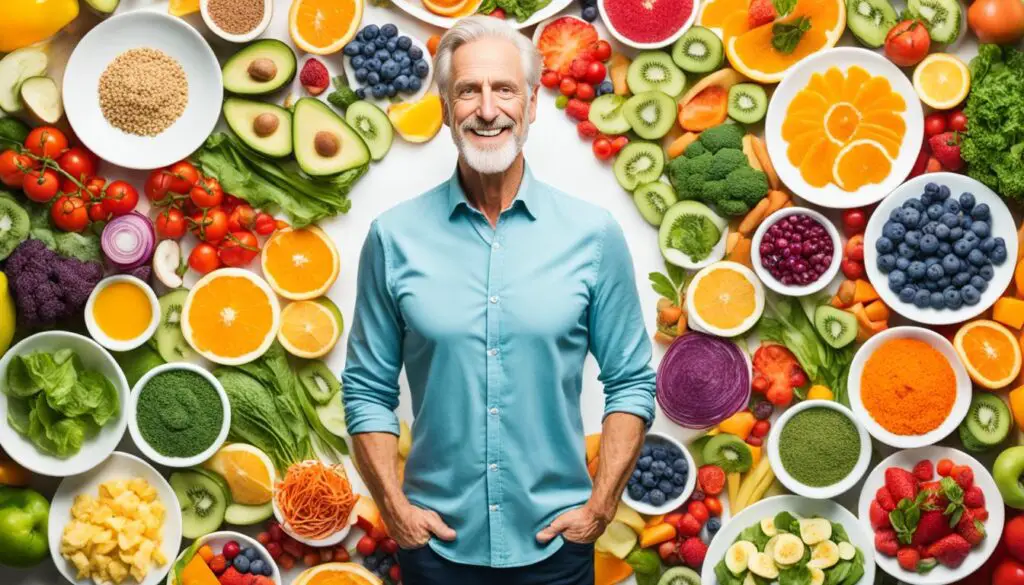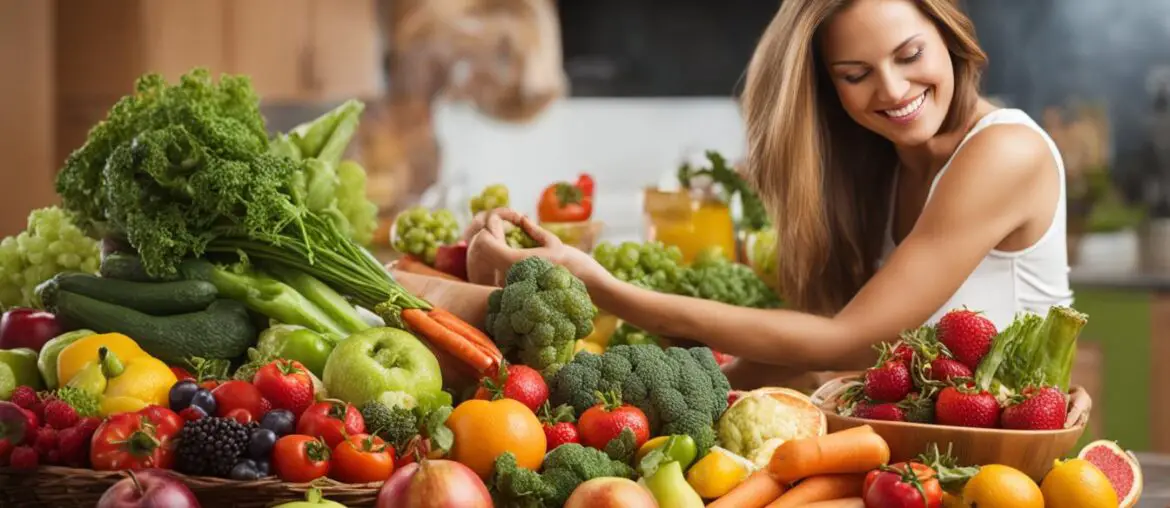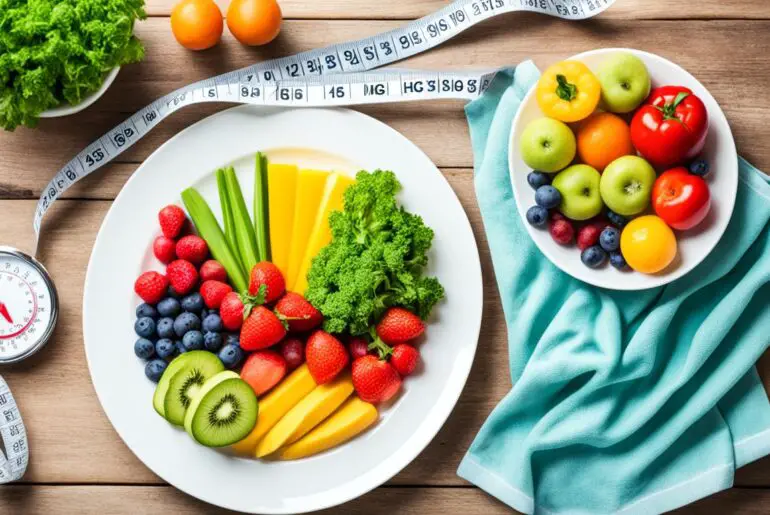Are you tired of struggling with hunger while trying to lose weight? Have you heard about the HCG diet and wonder if it can help you achieve your weight loss goals? The HCG diet is a popular weight loss protocol that combines the use of the hormone human chorionic gonadotropin (hCG) with a low-calorie diet. But what are the different phases of the HCG diet, and how can you manage hunger throughout the process?
Key Takeaways:
- Understanding the different phases of the HCG diet is crucial for successful weight loss.
- Hunger management is an important aspect of the HCG diet to ensure adherence and satisfaction.
- Follow specific guidelines and food restrictions for each phase of the HCG diet to maximize results.
- Incorporate hunger management strategies such as drinking plenty of water and consuming appetite suppressants.
- Overcoming weight loss plateaus and maintaining long-term success require careful attention to the HCG diet phases.
What is the HCG Diet?
The HCG diet, developed by Dr. Simeons, is a weight loss protocol that combines hCG supplementation with a very low-calorie diet. This unique approach aims to promote rapid weight loss while minimizing hunger and preserving lean muscle mass. The diet is divided into several phases, each with specific guidelines and food restrictions.
“The HCG diet offers a structured and intensive approach to weight loss,” says Dr. Simeons. “By using hCG injections or other forms of hCG supplementation, individuals can achieve significant results in a short period.”
The use of hCG, either through injections or alternative methods like drops or pellets, is a key component of the HCG diet. HCG is a hormone that is naturally produced during pregnancy and has been found to have potential weight loss benefits. It is believed to assist in controlling hunger, boosting metabolism, and promoting fat burning.
The HCG diet also incorporates a very low-calorie diet, typically around 500 calories per day. This calorie restriction, combined with hCG supplementation, is thought to reset the body’s metabolism and encourage the utilization of stored fat as an energy source.
Phases of the HCG Diet
The HCG diet consists of several phases, each designed to achieve specific goals and ensure sustainable weight loss. These phases include:
- The Loading Phase: This initial phase involves consuming high-fat foods for a period of two days while starting hCG supplementation. The purpose of this phase is to build up fat stores and prepare the body for the calorie-restricted phase.
- The Weight Loss Phase: Also known as the fat burn phase, this phase is characterized by a strict 500-calorie-per-day diet accompanied by daily hCG supplementation. Foods allowed during this phase are carefully selected to promote weight loss and provide essential nutrients.
- The Stabilization Phase: After achieving the desired weight loss, this phase focuses on transitioning to a higher-calorie diet while still avoiding sugars and starches. The goal is to stabilize the weight loss and establish long-term eating habits.
- The Maintenance Phase: The final phase of the HCG diet is all about long-term weight maintenance. Individuals are encouraged to continue making healthy food choices, incorporate regular exercise, and monitor their weight to prevent regain.
The HCG diet offers a unique approach to weight loss, relying on the combination of hCG supplementation and a low-calorie diet. It is important to consult with a healthcare professional before starting any weight loss program, including the HCG diet, to ensure safety and effectiveness.
HCG Diet Phases

The HCG diet consists of several phases, each with specific guidelines and objectives. These phases are designed to facilitate weight loss and teach healthy eating habits for long-term success.
In total, there are four phases in the HCG diet:
- The Loading Phase
- The Fat Burn Phase
- The Maintenance Phase
- The Rest of Your Life Phase
Each phase plays a crucial role in the overall effectiveness of the diet and should be followed diligently to achieve optimal results.
The Loading Phase
The loading phase, also known as the gorging phase, is the initial stage of the HCG diet. During this phase, individuals are encouraged to consume high-fat and high-calorie foods to build up fat stores. This provides the body with a reserve to draw upon during the subsequent phases when calorie intake is significantly reduced.
The Fat Burn Phase
The fat burn phase is the heart of the HCG diet. It involves consuming a very low-calorie diet of around 500 calories per day while continuing with HCG supplementation. This phase typically lasts for a specific duration, depending on individual goals and protocol variations. Following the strict food guidelines and portion control is essential for effective weight loss in this phase.
The Maintenance Phase
The maintenance phase marks the transition from the calorie-restricted fat burn phase to a higher calorie intake. This phase typically lasts for three weeks and allows for a gradual increase in calorie consumption. However, it is important to continue avoiding sugar and starch during this period. Daily weighing and monitoring weight stability are crucial during the maintenance phase.
The Rest of Your Life Phase
The final phase of the HCG diet is referred to as the “rest of your life” phase. It is the long-term maintenance phase that follows the completion of the protocol. During this phase, individuals are encouraged to continue making healthy food choices, incorporating regular exercise, and maintaining a balanced lifestyle to ensure long-term weight loss success.
By following the different phases of the HCG diet, individuals can experience effective weight loss while learning healthy eating habits that can be sustained for a lifetime.
| Phase | Description |
|---|---|
| Loading Phase | High-fat, high-calorie diet to build fat stores |
| Fat Burn Phase | Very low-calorie diet of around 500 calories per day |
| Maintenance Phase | Gradual increase in calorie intake while avoiding sugar and starch |
| Rest of Your Life Phase | Long-term maintenance phase emphasizing healthy habits |
Phase 1 – The Start
Phase 1 of the HCG Diet, also known as the gorging/loading phase, marks the beginning of the weight loss journey. During this phase, individuals are encouraged to eat as much fatty and oily foods as possible while taking hCG.
This phase is vital for avoiding extreme hunger during the first week of the diet. By consuming high-calorie foods, the body is primed to enter a state of ketosis and adjust to the low-calorie diet that follows.
The gorging/loading phase is often considered one of the hardest parts of the diet. It requires discipline and self-control to indulge in calorie-dense foods without overeating. However, this phase is crucial for jump-starting the metabolism and preparing the body for fat burning in the subsequent phases of the diet.
By allowing individuals to satisfy their cravings and experience a feeling of fullness, the gorging/loading phase sets the stage for better adherence to the low-calorie diet in Phase 2. It helps alleviate the potential for extreme hunger during the initial period, as the body adjusts to the reduced caloric intake.
Sample Gorging/Loading Phase Meal Plan:
| Meal | Food Choices |
|---|---|
| Breakfast | Bacon, eggs, avocado |
| Lunch | Cheeseburger with fries |
| Snack | Pizza, potato chips |
| Dinner | Steak, mashed potatoes, buttered vegetables |
| Snack | Ice cream, chocolate |
Remember, Phase 1 is a crucial component of the HCG Diet. It helps prepare your body for the subsequent phases and controls extreme hunger during the initial stages. Stay disciplined, follow the guidelines, and trust the process.
Phase 2 – Fat Burn

In Phase 2 of the HCG Diet, also known as the Fat Burn phase, individuals will follow a strict 500 calorie diet while using hCG supplementation. This phase is crucial for achieving significant weight loss. The diet focuses on specific food choices that encourage fat burning and minimize calorie intake.
Food Choices
During Phase 2, dieters must adhere to specific food guidelines to optimize fat burning. The diet emphasizes the following food choices:
- Lean proteins: Incorporate sources such as chicken breast, lean beef, white fish, and shrimp into your meals.
- Specific fruits and vegetables: Include options like apples, strawberries, grapefruit, spinach, cucumbers, and tomatoes.
- Limited starches: Avoid high-starch foods like potatoes, rice, pasta, and bread. Instead, opt for small portions of melba toast or grissini breadsticks.
By focusing on these food choices, individuals can maintain a low-calorie intake while still receiving necessary nutrients for the body.
It is important to remember that portion sizes and calorie counts should be strictly followed during Phase 2. Deviating from the recommended foods or exceeding the calorie limit may hinder weight loss progress and affect the effectiveness of the diet.
To get a better understanding of the suggested foods and their calorie content, refer to the table below:
| Food Item | Calories per Serving |
|---|---|
| Chicken Breast (Skinless) | 165 |
| Lean Beef (Top Sirloin) | 85 |
| White Fish (Cod) | 105 |
| Shrimp | 85 |
| Apple | 52 |
| Strawberries (1 cup) | 50 |
| Grapefruit | 52 |
| Spinach | 7 |
| Cucumber (1 cup) | 16 |
| Tomato | 22 |
| Melba Toast (1 piece) | 20 |
| Grissini Breadstick (1 piece) | 12 |
By selecting foods from this list, individuals can enjoy a variety of flavors while staying within the 500 calorie limit. Remember to consult with a healthcare professional before starting the HCG Diet and to personalize your food choices based on your specific needs and preferences.
Phase 3 – Maintenance Phase
Following the successful completion of the fat burn phase, individuals enter Phase 3 of the HCG diet, known as the maintenance phase. During this phase, the focus shifts from weight loss to stabilizing the achieved results and transitioning to a more sustainable eating plan. It is crucial to understand the principles and guidelines of the maintenance phase to ensure long-term success.
In the maintenance phase, individuals can gradually increase their calorie intake. However, it is important to note that this should be done with caution and in a controlled manner. A sudden increase in calories can lead to weight gain and jeopardize the progress made during the previous phases.
To effectively navigate the maintenance phase, it is essential to continue avoiding sugar and starch. These high-glycemic foods can disrupt the stabilization process and hinder weight maintenance. Instead, focus on incorporating a wider variety of nutrient-dense foods such as lean proteins, fruits, vegetables, and healthy fats into your meals.
During this phase, it is recommended to weigh yourself daily to ensure weight stability. This daily monitoring helps identify any fluctuations and enables you to make necessary adjustments to your calorie intake or food choices promptly.
Eating Strategies for Phase 3
Here are some helpful eating strategies to follow during the maintenance phase:
- Gradually increase your calorie intake over the course of the phase.
- Continue to focus on consuming whole, unprocessed foods.
- Avoid sugary and starchy foods, including desserts, bread, pasta, and pastries.
- Include lean proteins, such as chicken, fish, and tofu, in your meals.
- Incorporate a wide variety of fruits and vegetables for essential vitamins and minerals.
- Include healthy fats, such as avocados, nuts, and olive oil, in moderation.
- Stay hydrated by drinking plenty of water throughout the day.
- Maintain portion control and be mindful of your calorie intake.
By following these strategies and sticking to the guidelines of the maintenance phase, you can support weight stabilization and set the foundation for long-term success on the HCG diet.
“The maintenance phase is a critical period of the HCG diet, where careful attention to calorie intake and food choices is essential for sustaining and further building on your weight loss progress.”—Dr. Jane Smith, Nutrition Expert
| Phase 3 Guidelines | Do | Don’t |
|---|---|---|
| Gradually increase calorie intake | ✔️ | ❌ |
| Avoid sugar and starch | ✔️ | ❌ |
| Focus on nutrient-dense foods | ✔️ | ❌ |
| Weigh daily for monitoring | ✔️ | ❌ |
| Stay hydrated | ✔️ | ❌ |
| Practice portion control | ✔️ | ❌ |
Hunger Management Tips

Hunger management is crucial during the HCG Diet to avoid cheating or feeling unsatisfied. Here are some tips to help you control your appetite and stay on track:
- Drink Plenty of Water: Staying hydrated can help curb feelings of hunger. Aim to drink at least 8-10 glasses of water per day.
- Consume Appetite Suppressants: Incorporating natural appetite suppressants like coffee or green tea can help reduce cravings and control appetite.
- Space Out Meals: Instead of consuming large meals, try dividing your daily calorie intake into smaller, more frequent meals throughout the day. This can help keep you feeling satisfied and prevent extreme hunger.
- Never Skip Protein Portions: Protein is an essential nutrient that helps promote satiety. Make sure to include lean protein sources, such as chicken, fish, or tofu, in every meal.
- Utilize “Free Foods”: Certain vegetables, like lettuce, celery, and cucumbers, are considered “free foods” on the HCG Diet. These low-calorie options can be eaten in large quantities to help manage hunger without impacting your calorie intake significantly.
“Hunger management is crucial during the HCG Diet to avoid cheating or feeling unsatisfied.”
Plateau Breakers
A weight loss plateau can be frustrating for individuals following the HCG diet, especially when they are diligently adhering to the protocol. However, there are several effective plateau breakers that can help overcome this stagnation and jumpstart weight loss once again.
- Increasing water intake: Staying well-hydrated is essential for overall health and can also aid in breaking through a weight loss plateau. Drinking an adequate amount of water throughout the day can boost metabolism and promote proper digestion.
- Adjusting protein intake: Protein is a vital macronutrient for weight loss and muscle preservation. Tweaking the amount of protein consumed can help kickstart metabolism and break through a weight loss stall. Consult with a healthcare professional or nutritionist for specific protein recommendations.
- Trying an apple-only day: Incorporating an apple-only day into the HCG diet can serve as a short-term cleanse and shake things up metabolically. Apples are low in calories and rich in fiber, making them a refreshing and healthy choice to break through the plateau.
- Cutting down on beef consumption: While beef is a valuable source of protein, reducing the frequency of beef consumption during the HCG diet can potentially break a weight loss stall. Alternatively, focus on lean meats, poultry, and fish for variety and continued progress.
- Checking condiments for hidden sugars: Some condiments, such as salad dressings and sauces, may contain hidden sugars that can hinder weight loss. Pay attention to labels and opt for homemade or sugar-free condiment options to avoid unnecessary setbacks.
- Evaluating medication changes: Certain medications can interfere with weight loss progress. If you are experiencing a weight loss plateau, consult with your healthcare provider to review your current medications and explore potential alternatives that are less likely to impede your progress.
By implementing these plateau breakers, individuals can overcome the frustrating weight loss plateau and continue their journey towards their goals on the HCG diet.
Phase 4 – The Rest of Your Life

Phase 4 of the HCG diet, also known as the “rest of your life” phase, marks the transition into long-term maintenance after completing the protocol. During this phase, the focus shifts towards sustaining the weight loss achieved in the previous phases and nurturing a healthy lifestyle. To ensure long-term success, it is essential to continue making mindful food choices, avoid sugar and starch, and incorporate regular exercise into your daily routine.
Maintaining a balanced diet is key during this phase. Stick to whole, nutrient-dense foods such as lean proteins, fruits, vegetables, and whole grains. These choices will provide essential vitamins, minerals, and fiber to support overall health and weight management.
Avoiding sugar and starch remains vital in the maintenance phase. These empty-calorie foods can contribute to weight gain and hinder your progress. Opt for natural sweeteners, like stevia, and limit your intake of processed foods and refined grains.
In addition to a healthy diet, regular physical activity is crucial for sustaining weight loss and overall well-being. Incorporate exercises you enjoy, such as brisk walking, cycling, or strength training, into your daily routine. Aim for at least 150 minutes of moderate-intensity exercise or 75 minutes of vigorous exercise per week.
Remember, long-term success is not only about weight loss but also about adopting a sustainable and balanced lifestyle. The habits you develop during the HCG diet can serve as a foundation for lifelong health and wellness.
“The rest of your life” phase is an opportunity to solidify your achievements, maintain your weight loss, and continue prioritizing your well-being.
Conclusion
The HCG Diet offers a promising weight loss journey when approached with dedication and proper hunger management strategies. By following the different phases, monitoring calorie intake, and practicing appetite control, individuals can achieve successful weight loss and establish long-term maintenance.
Consulting with a healthcare professional before embarking on any weight loss program is important. They can provide personalized guidance and ensure the HCG Diet aligns with individual health goals and needs.
Remember, the HCG Diet is not a quick fix, but rather a holistic approach to weight loss. When combined with discipline, commitment, and a healthy lifestyle, it can be an effective tool for achieving your weight loss goals.
FAQ
What is the HCG Diet?
The HCG diet is a weight loss protocol developed by Dr. Simeons. It involves the use of hCG injections or other forms of hCG supplementation, combined with a very low-calorie diet.
What are the phases of the HCG Diet?
The HCG diet consists of several phases, including the loading phase, fat burn phase, maintenance phase, and the rest of your life phase.
What is Phase 1 of the HCG Diet?
Phase 1, known as the gorging/loading phase, requires individuals to eat as much fatty and oily foods as possible while taking hCG to avoid extreme hunger during the first week.
What is Phase 2 of the HCG Diet?
Phase 2, the fat burn phase, involves consuming only 500 calories per day and following specific food guidelines to achieve weight loss.
What is Phase 3 of the HCG Diet?
Phase 3, the maintenance phase, allows individuals to gradually increase their calorie intake and reintroduce a wider variety of foods after completing the fat burn phase. However, sugar and starch should still be avoided.
How can I manage hunger while on the HCG Diet?
Hunger management strategies include drinking plenty of water, consuming appetite suppressants like coffee or green tea, spacing out meals, never skipping protein portions, and utilizing “free foods” like certain vegetables.
What are plateau breakers in the HCG Diet?
Plateau breakers are strategies to overcome weight loss plateaus that may occur during the diet. These strategies include increasing water intake, adjusting protein intake, trying an apple-only day, cutting down on beef consumption, checking condiments for hidden sugars, and evaluating medication changes.
What is Phase 4 of the HCG Diet?
Phase 4, referred to as the “rest of your life” phase, is the long-term maintenance phase after completing the HCG diet. It emphasizes making healthy food choices, avoiding sugar and starch, and incorporating regular exercise into daily life.
What should I keep in mind during the HCG Diet?
It is important to consult with a healthcare professional before starting any weight loss program like the HCG diet. Following the different phases, monitoring calorie intake, and practicing appetite control can contribute to successful weight loss and long-term maintenance.




